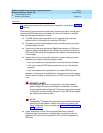
MERLIN LEGEND Communications System Release 6.1
Network Reference
555-661-150
Issue 1
August 1998
Call-Handling Scenarios
Page 2-10Networking Guidelines
2
Programming Regular Remote Access 2
For explicit remote access use by local system users (or by non-local users for
special maintenance purposes, for example), assign PSTN trunks to remote
access as you normally would, or use PRI dial-plan routed or DID trunks. Specify
that users
must
enter barrier codes for remote access. Do
not
assign tandem
trunks as dedicated or shared remote-access facilities.
Tandem Trunks 2
As Chapter 1, “Introduction,” explains, tandem trunks may be either PRI or tie
facilities. “Scenario 1: Two Systems, Tandem PRI Facilities” on page 16
explains
the advantages of PRI tandem trunks, which provide enhanced features and
performance over tie trunks. Tandem T1-emulated tie trunks provide faster call
setup and greater data speeds than analog tie trunks, although they do not
provide the full functionality of PRI. Analog tandem tie trunks may be required in
some private networks where the systems cannot support additional PRI or T1
facilities and remain within the 80-line capacity of a MERLIN LEGEND
Communications System. For examples, see “Scenario 3: Four Systems in a
Series, Mixed Facilities” on page 57 and “Scenario 4: Four Systems in a Star,
Mixed Facilities” on page 74.
In Release 6.1 and later systems, when planning for centralized VMS/AA, PRI
tandem trunks also provide faster Message Waiting light operation and the ability
for the centralized VMS/AA to determine whether calls originated on inside or
outside lines.
System managers must assign switch identifiers to designate, for each networked
trunk, the type and distance of the system connected to the other end of that
trunk. The identifiers serve several purposes: they assure the proper volume
levels on private network trunks and allow the proper routing for calls across the
private network. For example, if System A is connected to System B by a tandem
trunk, on System A that trunk must be programmed with the switch identifier for
System B, the system at the other end of the tandem trunk. Similarly, on System B
that trunk must be programmed with the switch identifier for System A.
NOTE:
The switch identifier is not programmed on the system that it identifies, but
is programmed on the tandem trunks of other systems connected directly
to it.
The number range of a switch identifier designates both the type of system
connected at the other end of a tandem trunk and the distance between the
systems in order to assure proper volume levels for calls (see “Scenario 4: Four
Systems in a Star, Mixed Facilities” on page 74 for an example). The distance is
expressed as
satellite (near)
or
non-satellite
(far) to designate systems closer
than 200 miles or further than 200 miles, respectively.A MERLIN LEGEND
Communications System is always identified by a number between 1 and 20 for


















